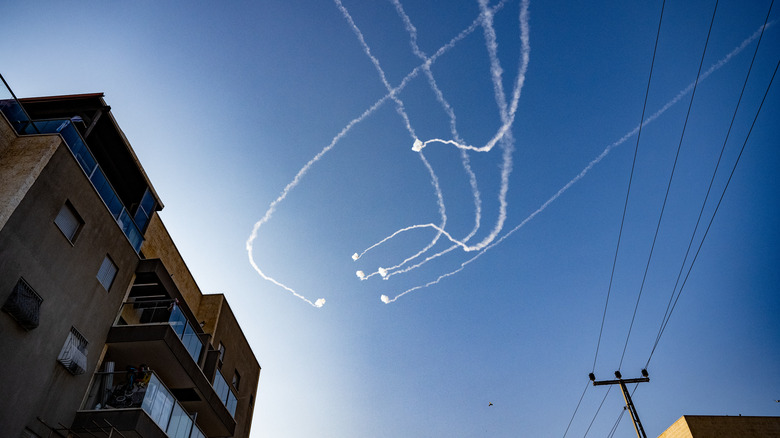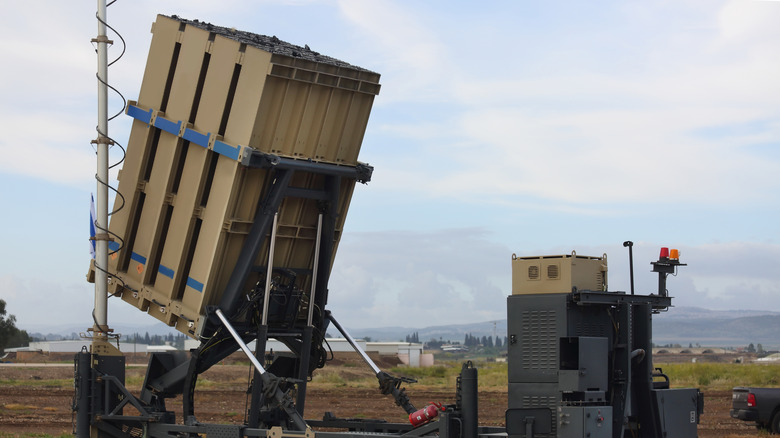What Is Israel's 'David's Sling' Missile System, And Is It Different From The Iron Dome?
Israel has never been shy about integrating cutting-edge technology into its military. The Israel-made Merkava main battle tank is one of the most legendary tanks of all time, and the country took things a step further in 2022 when it unveiled a new robotic drone tank. The Iron Dome and the rest of Israel's aerial defense network are also important tools in its arsenal.
Using a three-pronged system to neutralize threats, Israel's Iron Dome missile system is its primary form of defense from incoming rockets and missiles. It consists of a radar unit that alerts the system to the threat of a rocket, a control unit that analyzes the threat the rocket poses and maps a counterattack, and a firing unit that sends out a counter missile to deflect the incoming attack.
While the Iron Dome is mobile and primarily protects highly populated areas within the country, another defense system called David's Sling is stationary and keeps watch for medium-to-long-range attacks. David's Sling was designed to intercept projectiles fired from a range of 25 to 186 miles away. In comparison, the Iron Dome has a range of 58 square miles.
What is David's Sling?
Israel-based Rafael Advanced Defense Systems, the same defense contractor that developed the Iron Dome system, worked with U.S.-based Raytheon to develop David's Sling. Named after the biblical David and Goliath story, David's Sling uses an interceptor missile called the Stunner. This operates on a three-pulse solid propellant motor that drives it to speeds of up to Mach 7.5. While the Iron Dome missiles are designed with warheads, the Stunner stops incoming projectiles by colliding directly into them. For improved accuracy, the interceptor has an electro-optical/imaging infrared combo sensor that works with a radar seeker to detect threats in any weather condition.
Israel started working on David's Sling back in 2006. Two years later, the U.S. opened up its wallet for the project. However, it wasn't until March 2017 that David's Sling was fully operational. A year later, Israel used it for the first time in combat against two short-range ballistic missiles. However, further assessment by the system determined that these missiles wouldn't hit Israel after all, so the interceptors were redirected.
In April 2024, Iran sent a barrage of roughly 300 drones and ballistic missiles toward Israel in an aggressive attack, putting David's Sling to the test. According to Israel (via AP News), 99% of the attack was stopped by Israel's defense system.
Other pieces of Israel's defensive network
Rockets and missiles from neighboring regions aren't the only type of attack a country has to worry about. There are also aerial strikes from aircraft, which Israel is prepared for as well. Its Spyder defensive system is armed with Python-5 short-range missiles and Derby medium-range missiles that can intercept attacks up to 62 miles away.
Israel's most impressive system is the Arrow 2 and 3, which can hold up to six missiles, each with a range of nearly 1,500 miles and an altitude of 62 miles. Israel first saw the newly minted defense system in action when a group of Houthis attacked the city of Eilat in 2023. Notably, the Arrow 3 system doesn't use explosives to accomplish its goal. Instead, it relies on the force of its velocity and the damage it causes to prevent incoming attacks. With Arrow 2 and 3 working together, Israel has two chances to stop incoming attacks closer to their launchpads.


